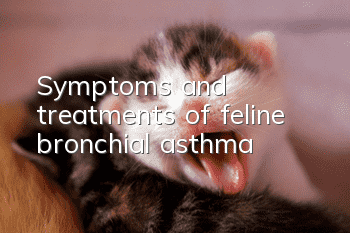Symptoms and treatments of feline bronchial asthma

Feline bronchial asthma is the same as human asthma, also known as chronic bronchitis. Most cases of bronchial asthma in cats are caused by allergies. Here’s a detailed introduction to feline bronchitis.
When cats are stimulated by allergens, serotonin present in platelets and mast cells will be released, causing tracheal smooth muscle contraction. Usually, such diseases will gradually become more serious, eventually leading to bronchiectasis and pulmonary qi. swell. Possible allergens include: grass, pollen, smoke, sprays (perfum, deodorant, flea spray, hair spray), cat litter dust, flea powder, dry cleaning powder, or food allergies, but are usually The allergen cannot be identified, and asthma symptoms will continue and may become more frequent. Most of them are mild chronic diseases and are related to allergies. If allergies are caused by allergens, it will cause an increase in tracheal secretions and stenosis of the trachea. Most affected cats will only have an attack for a few seconds to a few minutes. Cats may even have an attack only once every few months, but there are also a few cats that have intensive attacks every day. In this case, long-term treatment is necessary to control such symptoms.
Symptoms
Cats may have standard asthma symptoms. The cat will squat like a hen, extending its neck close to the ground, and then a rough wheezing sound will appear. Sometimes it will also be accompanied by coughing symptoms. As the severity increases, Depending on the degree or frequency of allergen occurrence, some cats will have it continuously throughout the day, while others will have it once every few days, or even mildly, only once every few months or years.
It is difficult to clinically diagnose whether a cat suffers from bronchial asthma. Because cats are relatively nervous animals, all of the symptoms they show may disappear in front of a doctor. At this time, The owner's description is crucial. When an owner describes symptoms that lead a veterinarian to suspect the possibility of cat asthma, a series of tests must be performed to rule out the possibility of other diseases.
Diagnosis
Complete blood count: Eosinophilia occurs in about 20% to 75% of cases.
Heartworm test: This can be used to rule out the possibility of heartworm infection.
Video recording of an attack: This is of great help to the author's clinical diagnosis. If the owner can videotape the cat during the attack, it will allow the veterinarian to more clearly confirm the symptoms of asthma.
Treatment methods for cat bronchial asthma
1. Treatment
1. Treatment of symptomsTreatment
Oxygen: When a cat has an acute attack and is cyanotic, an oxygen cage can relieve the symptoms
Steroids: In emergencies, intravenous steroids should be administered urgently.
Bronchodilators: In emergencies, Terbutaline can provide dilation of the trachea. Owners can even take such drugs home for backup. When breathing difficulties occur at home, they can be injected subcutaneously by themselves. If there is still no improvement, they can be administered at home. Inject again within 15 to 30 minutes.
2. Stage control (milder symptoms)
Steroids: Take prednisolone orally twice a day for 10 to 14 days, then gradually reduce the dose and frequency within 1 to 2 months. This is to find the lowest maintenance dose (the use of steroids can have an anti-inflammatory effect, thereby Control the frequency of disease attacks. In addition to making users obese and increasing appetite, the side effects of steroids can also cause diseases such as pancreatitis, diabetes, polyuria, and cystitis since patients generally need to take high doses of steroids for a long time.) . If there are difficulties in administration, there are also long-acting injectable steroids that can be used, such as methylprednisolone for intramuscular or subcutaneous injection. Some can be injected once every two weeks, and some can be injected once a month, depending on the severity of the attack.
Bronchodilators: should be used together with oral steroids, because anti-inflammation is the most important in the treatment of asthma.
Antibiotics: If there is concern about secondary bacterial infection, appropriate antibiotics should be selected based on bacterial culture.
Inhalants: Just like human asthma control, cats can also use inhalation sprays to control asthma symptoms. In order for cats to use inhalation sprays successfully, special equipment is required. Currently, there are special equipment for cat asthma. chamber(Aeroket) is available for use. Although inhaled sprays also contain steroids, since they are taken in the form of inhalation, inhaled steroids are only limited to the respiratory system, so the scope of the steroids' influence is only in the upper respiratory tract, and will not affect the organs of the whole body like oral steroids. .
2. How to use inhalants
1. Before using the inhaler for the first time or before using it for more than a week, gently squeeze both sides of the suction port cap, remove the suction port cap, shake the inhalant fully, and test spray the air to determine whether it is It can be used, and the dose of medication that comes out of this spray is usually higher.
2. The infusion should be shaken before each use and administered immediately.
3. Remove the suction port cover and insert the suction port into the dedicated chamber end.
4. Pay attention to the number of times the inhalant can be sprayed, and record how many days it can be used. After a few days, it must be replaced with a new inhalant. For example, most commonly used drugs areAfter 60 sprays, there are 59 sprays left after the first test spray. Each cat has one spray in the morning and one in the evening. Therefore, the inhalant will be used up about the 29th day after starting treatment, and new inhalation agents must be prepared as soon as possible. .
5. Attach the other end of the chamber containing the inhalant to a cat-specific mask, then tightly cover the cat's mouth and nose with the mask, and immediately press the inhalant to let the medicine spray out, and maintain the covering state 5 ~10 seconds.
6. After use, the inhalant should be removed, and the plastic part should be cleaned with clean water (the metal pill bottle part should not be exposed to water and should be removed before cleaning). After it is completely dry, reassemble it with the metal pill bottle for later use.
7. The Chamber (spacer) part should be cleaned and maintained regularly according to the manufacturer's recommendations. Most of the time, the chamber only needs to be soaked in dilute dishwashing liquid every week and then air-dried directly. There is no need to rinse with clean water. Because the soap component attached to the wall of the tube lumen makes it difficult for the sprayed gasified pharmaceutical particles to adhere to the wall of the tube, allowing the pharmaceutical particles to be optimally dispersed.
Weight control: If your cat is overweight, losing weight may reduce the symptoms of respiratory distress.
Allergen control: Avoid using dust-producing cat litter, ban smoking in the house, and regularly use medical-grade air filters to reduce dust mites, but most have limited effect.
Food: You can choose hypoallergenic prescription feed.
3. Prognosis
The prognosis is good in terms of short-term symptom control, but some chronic cases may still evolve into pulmonary fibrosis and emphysema.
- How to reduce stress when taking your cat out
- You can see beautiful cats in different shapes but you can’t suck them. Are you greedy?
- Healthy diet for cats and dogs: Analysis of the pros and cons of food selection
- Meow, I can’t help it, I’m just so cute! ! !
- Symptoms of pneumonia in Siamese kittens
- Cat vomits and doesn't eat for three days
- How to train a Korat cat to jump in a ring
- Is it necessary to buy cat grass?
- How to solve cat indigestion
- Does Silver Gradient recognize 2 owners?



